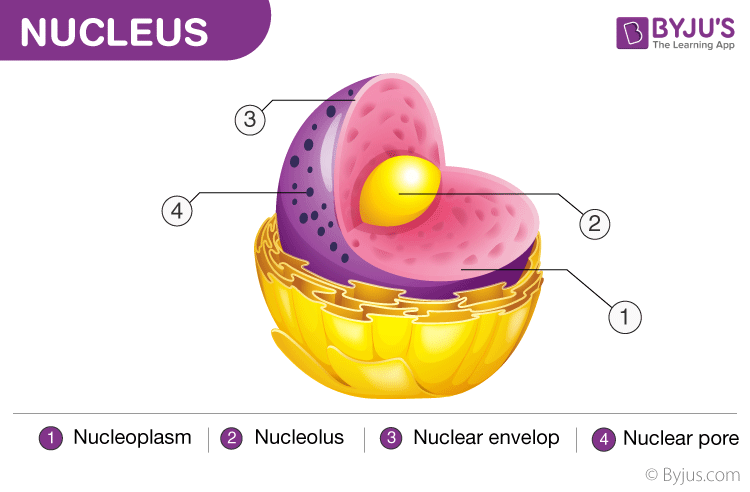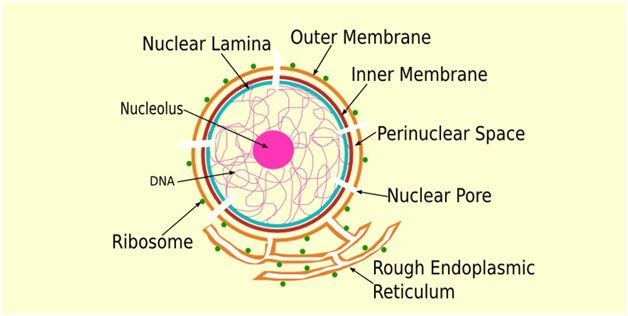Nuclear Membrane Definition
“Nuclear membrane is a double-layered membrane that separates the contents of the nucleus from the rest of the cell.”
What is the Nuclear Membrane?
All the eukaryotic cells that are found in plants, animals, fungi, and protists have a control centre, called a nucleus where DNA is stored. Every nucleus is girdled and covered by a double-layered membrane, known as the nuclear envelope or nuclear membrane. It separates the nucleoplasm (the fluid present in the nucleus), from the cytoplasm.

The nuclear envelope is also called nuclear membrane. It is made up of two lipid bilayer membranes
The nuclear membrane is present in both the plant and animal cells. Cells carry out a multitude of functions such as protein building, conversion of molecules into energy and elimination of unnecessary products.
This membrane guards the genetic material of the cells against the exterior of the nucleus where chemical reactions are taking place. Also, it carries several proteins which are crucial in the organization of DNA and to control genes.
Nuclear Membrane Structure
A nuclear membrane is composed up of two membranes – an inner and an outer membrane. Both membranes consist of phospholipids that are organized in a bilayer. The complete nuclear membrane includes four series of phospholipids.
The perinuclear space separates the outer and inner membrane. The outer membrane works by the rough endoplasmic reticulum. It is an organelle which is important in the transportation of proteins.

Nuclear Membrane Structure
The outer membrane and the rough endoplasmic reticulum both are covered in ribosomes as these are the true location of protein production.
On the nucleoplasm, nuclear lamina is connected to the inner nuclear membrane. The nuclear lamina also attaches to and secures chromatin which is organized loosely in protein structure and DNA. A protein layer gives support and strength to the nuclear membrane.
Also Read: The Nucleus
Parts Of Nuclear Membrane
The nuclear membrane encloses the cell nucleus and consists of the following parts:
Outer Membrane
It is a lipid bilayer containing two layers of molecules of lipid. The outer layer is made up of lipids which have ribosomes on the surface that are linked to the endoplasmic reticulum.
Inner Membrane
It contains proteins that rearrange the nucleus and chain the genetic material in position. The nuclear lamina is the attachment of proteins and fibres that are linked to the inner membrane. It provides structural support to the nucleus, assists in DNA repair, controls cell cycle events such as cell division and also on DNA replication.
Nuclear Pores
They move through both the inner and outer membranes of the nuclear membrane and are composed of large complex proteins which allow a few molecules to permeate by the nuclear envelope. Each of the nuclear pores consists of 30 distinct proteins which operate together to transfer materials. Also, they link the inner and outer membranes.
Nucleolus
These are tiny spherical bodies that are situated in the nucleus as they are usually present in a centralized site but are typically found closer to the nuclear membrane. What sets them apart from other nuclear material is that they are built by the (NOR)nucleolus organizing region of chromosomes, which is known to store the genes that are necessary for full ribosomal production. They encode ribosomal RNA subunits.
Nucleoplasm
Nucleoplasm is a remarkably viscous liquid that contains the nuclear hyaloplasm which is the more soluble and liquid portion of the nucleoplasm. It is a type of protoplasm that is similar to the cytoplasm, which is present throughout the cell body to the exterior of the nucleus.
As specific functions are carried out inside the nucleus, a different type of protoplasm is required. The constituents of the nucleoplasm are water, dissolved ions, and a blend of other substances. This element is completely confined in the nuclear envelope containing nucleotides and crucial enzymes that promote replication.
Also Read: Nucleoplasm
Nuclear Membrane Function
Following are the important functions of the nuclear membrane:
- The nuclear envelope has tiny holes which are identified as nuclear pores. The pores enable the content to flow in and out of the nucleus. It also connects the outer membrane and the inner membrane.
- The nuclear envelope’s surface area extends and doubles the nuclear pores during the interphase part of cell division.
- Nuclear membrane shields the nucleus with a double membrane by many pores that help in controlling the crossing of macromolecules such as proteins and RNA and permit free passage of water, ions, ATP and small molecules. The membrane controls the flow of information in the cell as it is conducted by the macromolecules.
Also Read: Nucleolus
Function Of Nucleus
The nucleus is a double-membrane bound cell organelle that is located in the eukaryotic cells and composes of the cell’s genetic material – the DNA. Since it maintains the integrity of the genes that control the gene expression hence controlling the cell’s activities, it is known as the control centre of the cell.
The following are the different roles of the nucleus:
- It is responsible for regulating the heredity traits of an entity
- It controls protein synthesis, growth, cell division, and differentiation
- It reserves heredity material in the form of DNA strands that also store RNA and proteins in the nucleolus
- It is a section for the process of transcription wherein mRNA is produced to generate proteins
- Assists in the exchange of RNA and DNA between the cell and the nucleus
- The nucleolus generates ribosomes that are referred to as protein factories
- It controls the integrity of gene expression and genes
Difference Between Nuclear Membrane in Plant and Animal Cells
The difference between the nuclear membrane in plant and animal cells are as follows:
| Nuclear Membrane in Plant Cell | Nuclear Membrane in Animal Cell |
| They lack several proteins. | They possess proteins. |
| The centrosome is absent. | The centrosome is present. |
To learn more about nuclear membrane, its structure and function keep visiting BYJU’S Biology or download BYJU’S app for further reference.
Frequently Asked Questions
What is the main function of the nuclear membrane?
The nuclear membrane encloses the DNA within the nucleus and protects it from the substances in the cytoplasm. It also regulates the entry and exit of substances in the nucleus.
How does the nuclear membrane appear like?
The nuclear membrane is made up of two lipid bilayer membranes that surround the nucleus containing the genetic material. The inner membrane and the outer membrane are separated by perinuclear space.
What is the difference between the cell membrane and the nuclear membrane?
The cell membrane is the lipid bilayer surrounding the entire cell. The nuclear membrane, on the other hand, surrounds the nucleus. The cell membrane is in the form of a continuous sheet. On the contrary, the nuclear membrane is not a continuous sheet but is made of a series of vesicles that come together to enclose the nucleus.
Why does the nuclear envelope break during mitosis?
During mitosis, the nuclear membrane breaks to allow the mitotic spindle fibres to attach to the chromosomes.
What would happen if the nucleus had no membrane?
The nuclear membrane provides proper shape to the nucleus and ensures that the cytoplasm does not leak into the nucleus. If the nuclear membrane was absent, the molecules in the cytoplasm would enter into the nucleus and destroy a part of the DNA. This would impair the functioning of the cell and would lead to cell death.

whats the potential in eV of the nuclear membrane